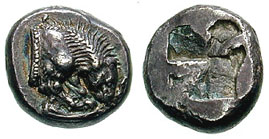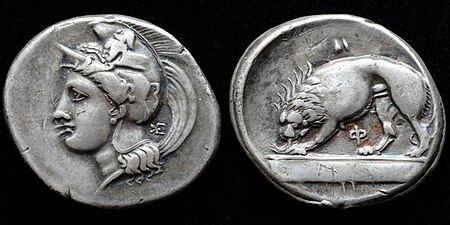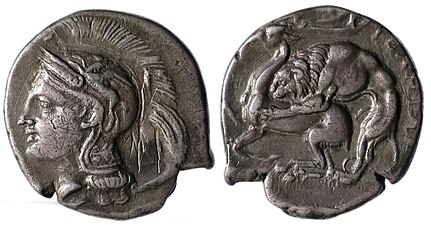Velia
This article needs additional citations for verification. (July 2018) |
Ancient Greek: Ὑέλη, Ελέα | |
 View of the excavations and the tower at Velia | |
| Alternative name | Hyele, Ele, Elea |
|---|---|
| Location | Velia, Province of Salerno, Campania, Italy |
| Region | Magna Graecia |
| Coordinates | 40°09′39″N 15°09′18″E / 40.16083°N 15.15500°E |
| Type | city |
| History | |
| Builder | Settlers from Phocaea |
| Founded | Between 538 and 535 BC |
| Associated with | Parmenides, Zeno, Statius |
| Site notes | |
| Website | Parco archeologico di Elea-Velia (in Italian) |
Velia was the Roman name of an ancient city on the coast of the Tyrrhenian Sea. It is located near the modern village of Novi Velia near Ascea in the Province of Salerno, Italy.
It was founded by Greeks from Phocaea as Hyele (Ancient Greek: Ὑέλη) around 538–535 BC. The name later changed to Ele and then Elea (/ˈɛliə/; Ancient Greek: Ἐλέα) before it became known by its current Latin and Italian name during the Roman era.
The city was known for being the home of the philosophers Parmenides and Zeno of Elea, as well as the Eleatic school of which they were a part.
Geography
[edit]The site of the acropolis of ancient Elea was once a promontory called Castello a Mare, meaning "castle on the sea" in Italian. It now lies inland and was renamed Castellammare della Bruca in the Middle Ages. The city later developed on the coastal plain below.
History
[edit]
According to Herodotus, in 545 BC Ionian Greeks fled Phocaea, in modern Turkey, which was being besieged by the Persians.[citation needed] After some wanderings (8 to 10 years) at sea, they stopped in Reggio Calabria, where they were probably joined by Xenophanes, who was at the time at Messina, and then moved north along the coast and founded the town of Hyele. According to Virgil,[1] Velia is the place where the body of Palinurus washed ashore.[2]
Around the 5th century BC, the city was known for its flourishing trade relations. It also took on considerable cultural importance for its pre-Socratic philosophical school, known as the Eleatic School, founded by Parmenides and carried forward by his student Zeno, famous for his paradoxes.
In the 4th century it entered the league of cities committed to stopping the advance of the Lucanians, who had already occupied nearby Poseidonia (Paestum) and were threatening Elea.
It joined an alliance with Rome in 273 BC and was included in the ancient province of Lucania.[citation needed] Elea had excellent relations with Rome: it supplied ships for the Punic wars (3rd-2nd century) and sent young priestesses for the cult of Demeter (Ceres), coming from the local aristocratic families. It became a holiday and health resort for Roman aristocrats, perhaps also thanks to the presence of the medical-philosophical school.
In 88 BC Elea was ascribed to the Romilia tribe, becoming a Roman municipium with the name of Velia, but with the right to maintain the Greek language and to mint its own coins. In the second half of the 1st century BC it served as a naval base, first for Brutus (44 BC) and then for Octavian (38 BC). The prosperity of the city continued until the end of the 1st century AD, when numerous villas and small settlements were built, together with new public buildings and thermae, but the progressive silting up of the port led the city to progressive isolation and impoverishment.
From the end of the imperial age, the last inhabitants were forced to take refuge in the upper part of the Acropolis to escape the advancement of marshy land.
The site
[edit]
Remains of the city walls can be seen, with traces of one gate and several towers, of a total length of over three miles, and belong to three different periods, in all of which the local crystalline limestone is used.
Bricks with Greek brick-stamps were also employed in later times of a unique shape, each having two rectangular channels on one side.
There are remains of cisterns.[3]
In 2022, excavations led to the discovery of the archaic temple of Athena on the acropolis of Velia. The oldest temple dates to 540-530 BC, the years following the battle of Alalia.[4] Two well-preserved bronze Greek helmets with Etruscan design found there including metal fragments from weapons are thought to be offerings to the goddess after the battle.[5]
-
The Porta Rosa road was the main street of Elea, circa 4th-3rd centuries BC
-
The medieval tower of Velia built out of a Greek temple
Famous residents
[edit]- The father of the Roman poet Publius Papinius Statius was born in Hyele (Silv 5.3.127).
- Parmenides, philosopher and founder of the Eleatics
- Zeno of Elea, Eleatic philosopher known for his paradoxes
Coins
[edit]-
Drachma, circa 535-510 BC
-
Stater struck 334-300 BC
-
Silver coin from Velia, circa 280 BC, with Athena on the obverse, and a lion devouring a stag on the reverse
See also
[edit]References
[edit]- ^ Virgil, Book 6 Aeneid
- ^ Frederick Ahl (trans.), ed. (2007). Virgil's Aeneid. Oxford UP. pp. 139–40. ISBN 978-0-19-923195-9.
- ^ One or more of the preceding sentences incorporates text from a publication now in the public domain: Ashby, Thomas (1911). "Velia". In Chisholm, Hugh (ed.). Encyclopædia Britannica. Vol. 27 (11th ed.). Cambridge University Press. p. 978.
- ^ Acropoli di Velia: riemerge il tempio arcaico di Atena https://www.classicult.it/acropoli-di-velia-tempio-arcaico-di-atena/
- ^ D'emilio, Frances. "Ancient helmets, temple ruins found at dig in southern Italy". phys.org. Retrieved 2022-02-27.
External links
[edit]- Official website (in Italian)
- Cilento National Park website (in Italian)
- Populated places established in the 6th century BC
- Phocaean colonies
- Ionian colonies in Magna Graecia
- Roman towns and cities in Magna Grecia
- World Heritage Sites in Italy
- Frazioni of the Province of Salerno
- Localities of Cilento
- Former populated places in Italy
- Greek colonies in Lucania
- Archaeological sites in Campania
- Ancient Greek archaeological sites in Italy
- National museums of Italy









